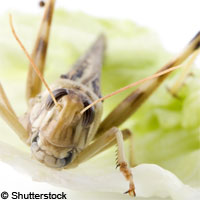No task is too complex for locusts
British and American scientists writing in Current Biology have shown for the first time that locusts use vision rather than touch to find footholds. The study sheds new light on the ability of insects to perform complex tasks, such as visually-guided limb control, which is usually associated with mammals. For nearly four decades, locusts have been viewed as a model organism in studying limb control. Observing insects has led to breakthroughs in neuroscience and has served to inspire engineers working on limb control in robotics. 'This is another example of insects performing a behaviour we previously thought was restricted to relatively big-brained animals with sophisticated motor control such as humans, monkeys or octopuses,' explained Dr Jeremy Niven of the University of Cambridge in the UK who worked on the study. Because insects such as bees and flies spend a lot of time flying, much research has concentrated on how insects use vision during flight. For insects that walk, including stick insects, crickets and cockroaches, experiments have typically focused on antennae response measurements. This is because walking insects have relatively small eyes and use long antennae to 'feel' their way through the environment. Locusts spend time both walking and flying, and have short antennae and large eyes. These characteristics made scientists wonder whether they used both to find footholds. To answer this question, researchers built a miniature locust-sized ladder and filmed the locusts walking along it by using high-speed video cameras. Video analysis showed that the locusts targeted their front legs to specific rungs in the absence of any previous contact suggesting that visual information alone is sufficient for targeting single steps. Accurate placement, though, depended on mechanosensory inputs from antennae and feedback from certain limbs. Researchers also wanted to know if a locust used visual information obtained before and/or during the onset of a step. To do so, they set up an infrared beam which triggered movement placing a rung further away after the locust began a step up. In many cases, the locust appeared to stumble as a result. This highlights the importance of vision to the stability of walking locusts. 'By combining all these different experiments, we showed that locusts use vision to place their legs,' Dr Niven pointed out. 'We showed that when locusts can't see one front leg they stop using that leg to reach to the next ladder rung, favouring the leg they can see. Big-brained mammals have more neurons in their visual systems than a locust has in its entire nervous system, so our results show that small brains can perform complex tasks. Insects show us how different animals have evolved totally different strategies for doing similar tasks.' As well as illustrating how insects can achieve similar results to mammals by using simpler mechanisms, the findings deepen scientific understanding of locusts' neural circuits.
Countries
United Kingdom



